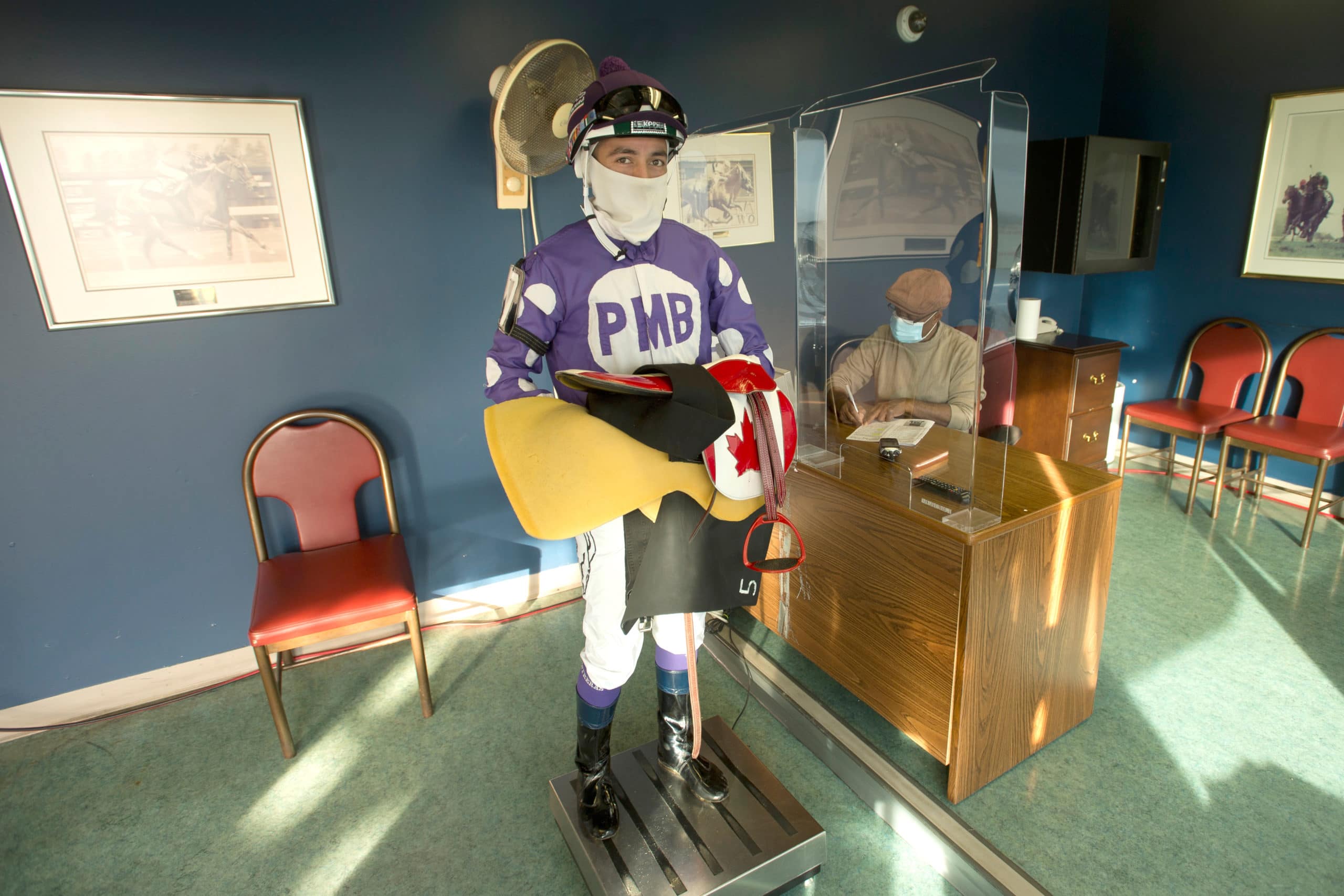Racehorses carry extra weight so that ‒ in theory ‒ they all arrive at the finish line at the same time.
Of course, while a noble and ambitious goal, this almost never happens because this is racing and a lot of influence is inflicted by the track conditions, the weather, the distance, the jockey, the company, the horse’s fitness and even how it is feeling on that particular day. But the idea of weight assignments is to give the horse, its connections and the betting public the fairest chance of finishing in the money.

Hitting the line together: a rare triple dead-heat for the win in a $15,000 claiming race at Evangeline Downs in Louisiana in 2014.
Conditions of races are made up by racing secretaries to determine weights. Weights are added to most entrants in a horse race and vary based on the weight assigned to each horse and the weight of the jockey (not including the helmet, blinkers, number cloth, whip or safety vest). Weight requirements vary from race to race and track to track, but generally horses carry between 112 and 126 pounds, which includes the jockey and about seven pounds of gear.
In most cases, the racing secretary chooses a maximum weight for a given race condition and subtracts different allowances for each horse based on its individual profile. Scott Lane, Thoroughbred Racing Secretary at Woodbine, explains, “Essentially what happens is in every race we start off with a base weight.” As an example here he chose a random $10,000 claiming race at Woodbine. “In this race, 124 lbs is the maximum amount of weight that can be allotted.” If a horse is carrying the full weight, “that means they have no claiming allowances ‒ in this case, two pounds if you buy down the claiming price (i.e. $9,500 instead of $10,000). Also, three-year-olds will be give a three-pound allowance over older horses in this race. In an open race, you would get a three-pound filly or mare sex allowance as well.
“Back in the early days of racing there was a Jockey Club scale of weights that jurisdictions would try to follow ‒ that’s kind of been abolished over the past few years,” he explains. “Essentially in Ontario all we’re required is that the minimum assigned weight is 105 lbs. However, we have now implemented a process here where the minimum weight assigned would be 118 lbs, excluding sex allowances and apprentice rider [bug] allowances. We made that amendment to our set of weight assignments this year because prior to 2020 we would get horses that were coming in at 111, 110 lbs without a bug or sex allowance.
“That’s why we offer the weight allowances for different criteria ‒ non-winners of a race for X amount of time, sex allowance, weight-for-age allowance for three-year-olds running against older horses, Canadian-bred incentive allowances in two- and three-year-old races (3 lbs over a US-bred horse). So we offer incentives to try to balance it out to make it as equal as possible.”
The weight is added via a couple of weight systems currently in use, based on preference. Actual lead weights in the saddle or saddle pad slots have generally been replaced by high-density polymer and vulcanized rubber, and some prefer weighted foam saddle pads. Individual weights vary between .5 and 1.5 lbs.
There has been lots of discussion over the years about the ‘dead weight’ of lead vs. the ‘live weight’ of the human rider. It was believed that (without hard evidence) the jockey was better able to shift his weight to remain in balance with the horse, which is especially important in steeplechasing. Of course, the opposite can be true, where a shift in weight can unbalance the horse.
Hitting the Ceiling
So how much is too much? Lane says, “There is not set maximum weight, it is all based on my judgment. Here at Woodbine, the maximum I’ve allotted any horse to carry was 128 lbs, which Pink Lloyd has carried on various occasions. He’s kind of the benchmark of what the top horses have been carrying over the past couple of years here. If any other horses were entered into the same races that fit the same criteria as Pink Lloyd, they would have carried the same amount of weight.”
So what was the highest weight ever carried by a horse? In 1968, the great Dr. Fager carried 130 lbs or more in every race that season, culminating with a 139 lb. assignment in the Vosburgh Handicap at Aqueduct. It obviously didn’t slow him down that much; he won by six lengths and broke the track record by a full second.
Another legend, multiple Horse of the Year Forego, won under Bill Shoemaker in the 1976 Marlboro Cup Handicap carrying 137 lbs to narrowly win over Honest Pleasure, a three-year-old who was only saddled with 119 lbs. It is thought that Man O’ War’s retirement may have been expedited by Jockey Club handicapper Walter Vosburgh’s suggestion that the colt would have to carry up to 150 pounds after his three-year-old campaign, during which he carried as much as 138 lbs.

Woodbine jockey Luis Contreras weighing in (note that vest and helmet weight are subtracted from the total). Jockeys must also weigh in after the race at roughly the same weight, not exceeding two pounds underweight. If short by more than two pounds his/her mount is disqualified. (Michael Burns photo)
Human Welfare
It is well known that jockeys go to extraordinary lengths to keep their weight down ‒ sometimes to the detriment of their health. A recent push to raise minimum weights at many tracks in North America hopes to slightly ease the constant battle of the scales.
Woodbine, in consultation with the Horsemen’s Benevolent and Protective Association of Ontario, announced that in August of this year it was raising the minimum weight for jockeys to 118 pounds. Top-end weights went to 125 pounds where applicable, other than handicap races or stakes races where assigned weights would remain at the discretion of the racing secretary.
“We’ve upped our scale of weights here with the jockeys’ health and well-being and their best interests in mind,” says Lane. “We’ve made that small amendment this year; the same horses with the same criteria as last year are carrying usually two to four more pounds than they would have been this time last year in the same races.
“The jockeys were very receptive to this modification that we made. These horses are continually exercising with 140, 145 pounds in the morning, so a couple of extra pounds is beneficial to the jockey and not detrimental to the health and welfare of the horse whatsoever.”
By comparison, a 1929 chart book indicates maximum weights as low as 95 lbs. In those days, jockeys had to resort to some horrifically extreme purging methods including tapeworm pills, vomiting and ‘exploding’ laxative potions.
Does Weight Really Matter?
The answer is … maybe. Craig Milkowski, Chief Speed Figure Analyst at TimeformUS.com, has done extensive studies on how weight affects Beyer speed figures. He writes in an online forum:
“After gathering all the information I could and testing things out on a big database, I came to a few conclusions. First, I agree with Nick [Mordin, see below] and others that weight changes at very low weights mean little. If a horse goes from 110 to 105, it doesn’t run any faster. The point where weight seems to start to matter is around 115-117 pounds. If a horse drops from 126 to 110, only about 10 pounds seem to matter.
“Around that range and above, I found that extra weight carried slows horses about one Beyer point [Beyer rating being how fast a horse has run in each of his starts] for every three pounds. Since the Beyer scale varies by distance, you have to convert to lengths. For example, if a horse dropped from 126 to 120, he would lose 6 pounds and should be expected to run about 2 Beyer points faster. At 6f, that is one length, while at 1m 1/2 it is about two lengths.”
Other handicappers swear by the formula that 1 lb of additional weight is equal to 1/5 of a second, which translates to one horse length in a mile race.
Interesting to note, however, that in Betting for a Living, British author Nick Mordin wrote: “The idea of downgrading a horse’s chances when it carries more weight seems quite attractive and logical at first. After all, a horse really ought to run slower if you put more weight on its back. So if one horse lost narrowly to another the last time they met it should reverse the placings if it now carries comparatively less weight.”
In theory, yes, but not in the real world, as evidenced from a survey of 222 races selected at random from the form book over a three-year period that involved a rematch, where two horses who finished close to each other (within 2 lengths) in their previous race met again. This is what happened:
- When the weight remained the same or the loser carried relatively more weight, the loser lost again 56 times out of 96 — or 58 percent of the time.
- When the loser carried relatively less weight than the horse who beat him, it lost again 73 times out of 126 — again 58 percent of the time.
“On average there was a weight shift in favor of the loser in these races of 2.45 lbs. According to the age-old handicapping formula, that kind of weight shift should have been enough to reverse the placings in the majority of races in the survey. But it didn’t happen.”
Are True Handicap Races Extinct in Canada?
A handicap is a race where each horse is allocated a weight, according to its ability (rather than a set age/sex formula) in an attempt to equalize every horse’s chance of winning. Handicaps are much more common in Europe, especially the UK, than in Canada, and include the Grand National steeplechase in England and the Melbourne Cup in Australia.
Lane notes that in Europe, weight assignments are more integral to their racing programs; essentially all of their races, from overnights to top stakes, are all assigned weight handicaps. New York state continues to run quite a few as well.
“In New York, the majority of their four-year-olds and upward stakes races are still handicap races, and a few other jurisdictions have them sparsely throughout. We don’t have any handicap stakes races any more here in Ontario, just some novelty Welcome Back, Mid-Summer and Grey Handicaps. Some are races we create here for Starter Handicap eligibility horses ‒ we try to separate them from the top horses to the horses with the worst form and assign the weights to try to make it as balanced as possible.”
Down the Road
Will racing weights continue to increase?
“That’s all up for debate,” suggests Lane, adding, “at this point I haven’t heard anything reflective of that. Throughout North America this year the base weights have gone up a couple of pounds. I definitely anticipate that over the coming years you’ll see the base weight will always increase; they will never decrease.
“We look at it from a different perspective than the historians did back in the early days of racing where essentially they were fine with horses getting in with 100 pounds or 98 pounds. Those days are long gone. We are more inclined to be concerned about the health and welfare of the human element ‒ the riders ‒ so that they’re in the best condition they can possibly be and not struggling to get down to certain weights and putting themselves in danger.”

Norman Rockwell’s “Weighing In”


